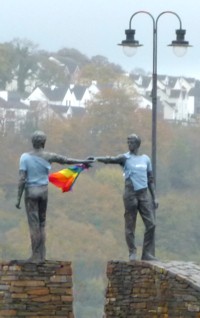The Celtic Tiger
Meanwhile, in the south, the Republic was a major beneficiary of EEC membership and its economy began to accelerate. First Ireland had success with butter then with IT.
The Butter Museum in Cork records the Irish butter success story.
Until the 1950's Irish butter making was both primitive and unhygienic.
Farmers wives were still hand milking and using a domestic separator and a hand churn to make butter.
Then came the European Economic Community.
Modern milking sheds; bulk handling; and processing factories were built; improved herds and pastures brought Irish butter into the 20th century.
Thus butter became a first step in the late 20th century Irish economic miracle.
Soon educated Irishmen and women returned from overseas and foreign immigrants reversed the old pattern of brighter children emigrating as soon as they were able. Ireland's population began to grow and among these new Irish the old religious enmities were put aside in the interests of a better society. For a period, at the turn of the century, the economy grew so spectacularly that the Republic would be called the 'Celtic Tiger'.
So today it's a different story. Ireland is no longer represented by a three centimetre thick computer printout of inappropriate jokes about stupidity. As we'd hoped in the early 1970's, both Britain and the Republic of Ireland are, or were, members of the EU and the border is indeed transparent. The military control points have long gone. Traffic flows are unhindered by what has become a line on the map and people from either side of the border mix freely, as they do across state or provincial borders in Australia, Canada or the US.
The only noticeable difference when one crosses this border is that the road signs revert to imperial distances and miles per hour and Euros give way to Pounds.

